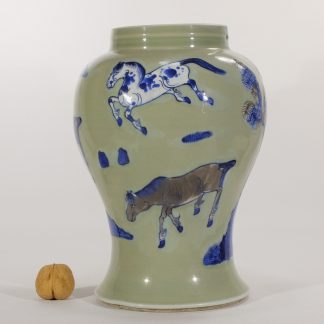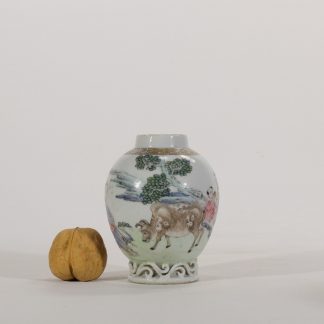Description
Description: Chinese porcelain big plate painted in famille rose palette, depicting XiWangMU, the Queen Mother of the West, seated in a garden with a deer and a basket of lingzhis, all symbols of longevity.
This rare plate is completely damaged. It is strongly suggested to read the notes about this damage in the Notes here below.
Dating: 18th century, Yongzheng, Qing dynasty.
Size: 39.2 cm diameter
Provenance: Antiquarian market
References: A dish with this exact motif, although smaller, is illustrated at page 38 of “China to order” by Daniel Nadler, and dated 1723 – 1735.
Notes: From Wikipedia:
“The Queen Mother of the West is most often depicted holding court within her palace on the mythological Mount Kunlun, usually supposed to be in western China (a modern Mount Kunlun is named after this). Her palace is believed to be a perfect and complete paradise, where it was used as a meeting place for the deities and a cosmic pillar where communications between deities and humans were possible.[10] At her palace she was surrounded by a female retinue of prominent goddesses and spiritual attendants. One of her symbols is the Big Dipper. Although not definite there are many beliefs that her garden had a special orchard of longevity peaches which would ripen once every three thousand years,[10] others believe though that her court on Mount Kunlun was nearby to the orchard of the Peaches of Immortality. No matter where the peaches were located, the Queen Mother of the West is widely known for serving peaches to her guests, which would then make them immortal. She normally wears a distinctive headdress with the Peaches of Immortality suspended from it.”
A note about the damages of this plate. Having three restorers in the family (although not about porcelain) and because of the Italian approach to restoration, which is addressed to do the minimum necessary, and leaving the restored parts visible, my approach to restoration is to let the damage visible, as said here elsewhere; the so-called “conservatory restoration”, the standard adopted by our Museums. This dish, when found, had a chip at about ten o’clock on the border. Because of its rarity, the size, and the spectacular decoration, I decided in this case to have it “professionally restored”, as it is said, with an invisible restoration. Well, after that, one day I took the dish for dusting it. At which point did I grab it? The Murphy’s law is infallible: exactly in the point of the chip. Result: I remained with the chip in hands and the plate went to the floor. In conclusion, the only time that I have been tempted by invisible restoration, it has been more than enough.







Reviews
There are no reviews yet.